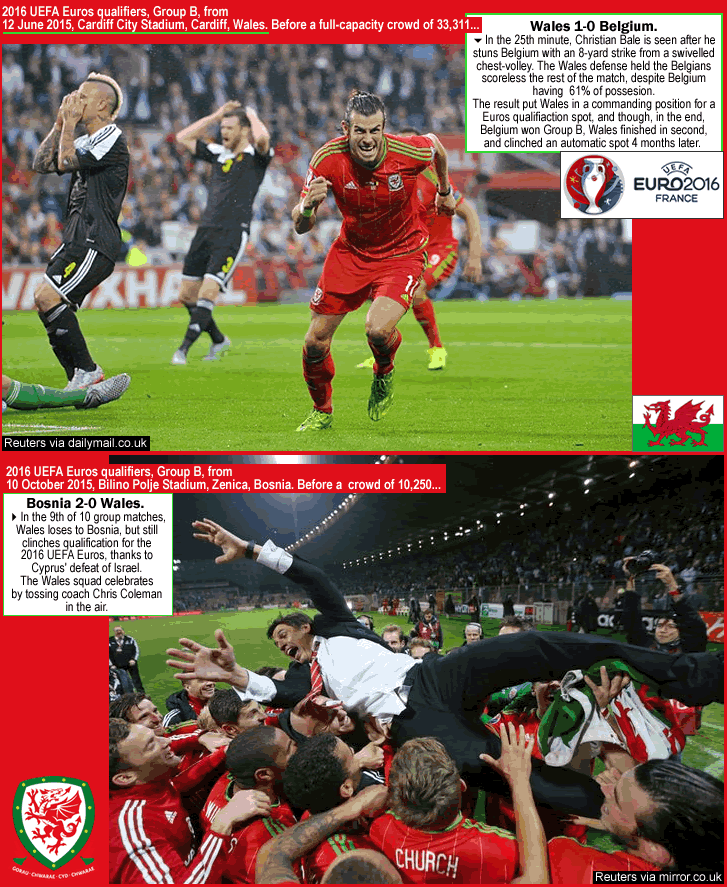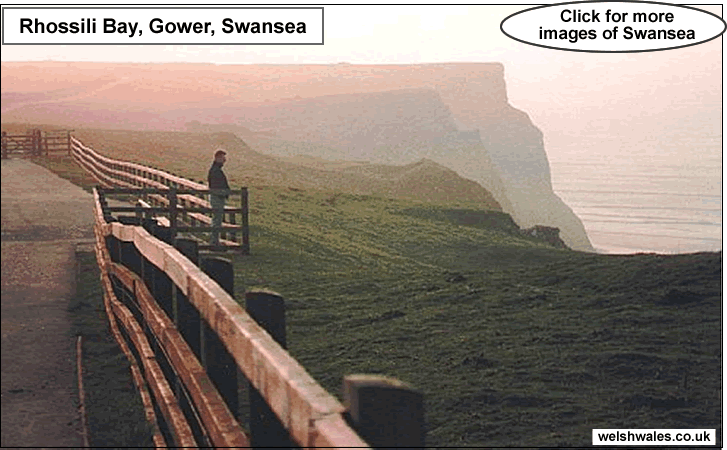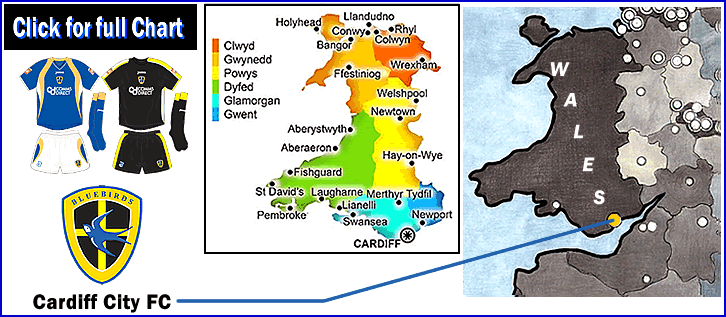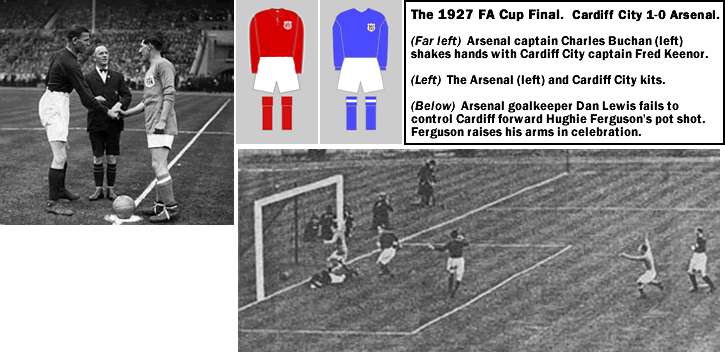Links…
-Squad chart.
-Article on Wales clinching… Joy in Bosnia defeat as Wales make history to qualify for Euro 2016 (by Stuart James at guardian.com on 10 Oct. 2015).
-Team (current squad info)…Wales national football team/Current squad (en.wikipedia.org).
-Team, with schedule, etc…WALES (soccerway.com).
-Country…Wales (en.wikipedia.org).
-The UEFA Euros tournament in France in June 2016…UEFA Euro 2016 (en.wikipedia.org).
-
Wales national team: starting line-up (Best XI), from match which clinched their qualification
(Chart of Wales starting squad from 10 October 2015, Bosnia 2-0 Wales: 17 players + coach are profiled.)
[The Group B match-day which saw Wales automatically qualify for the 2016 UEFA Euros tournament in France].
By Bill Turianski on 10 November 2015; twitter.com/billsportsmaps.com.
Demographics of Wales
Size of Wales:
20,779 km-squared (or 8,022 square miles). Wales is about 86% of the size-by-area as the island of Cyprus (which would include the de-facto-state of Northern Cyprus), or about 92% of the size of the state of New Jersey in the USA. This is [about the equivalent of] the ~165th-largest country by area, placing them between Cyprus and Brunei (that is, if Wales were an independent nation, as opposed to what they are [a constituent state of the United Kingdom]).
{Sources: Wales;
List of countries and dependencies by area;
List of U.S. states and territories by area (en.wikipedia.org).}
Population of Wales:
Wales has a population of around 3.0 million {2011 census}. Wales is [about the equivalent of] the ~141st-most-populous country, placing them between Armenia and Lithuania (that is, if Wales were an independent nation, as opposed to what they are [a constituent state of the United Kingdom]).
{Sources: Wales;
List of countries and dependencies by population (en.wikipedia.org).}
Capital & largest city:
Cardiff, city population: about 346,000. Greater Cardiff metro-area population.: about 1.0 million {2011 census figures}.
…
Wales were in a qualifying group (Group B) with Belgium, Bosnia, Israel, Cyprus, and Andorra…
On 12 June 2015, in matchday 6 (of 10), before a full-capacity crowd of 33,000 at Cardiff City Stadium, Wales stunned the heavy favorites Belgium with a 1-0 win {see first photo in the illustration below}. That upset win came from an unusual goal scored by their talisman, Christian Bale, in the 25th minute, from a Wales corner-kick. The bizarre play saw no less than 4 consecutive headers (3 by Belgian players/ the last header an error by Belgian MF Radja Nainggolan as he tried to head the goal back to the Belgian goalkeeper). The finish was a skillful swiveled volley after a chest-trap, from short range, by Bale. The ball never touched the ground after the corner-kick and those 4 headers…until Bale intercepted that errant fourth header, and deftly slotted the ball, on the volley, straight through Belgian ‘keeper Thibault Courtois’ legs. Here is that ultimately crucial goal for Wales, via a 36-second youtube video, Wales v Belgium bale winning goal 12/6/15 (uploaded by gavin drobach at youtube.com).
The upset win that day in Cardiff was then sealed by the solid Wales defense (led by captain Ashley Williams), which held the potent Belgian offense scoreless – this despite the fact that Belgium had 61% of the possession that game. {See this article for a report on that match, Wales go clear as Bale strike defeats Belgium (uefa.com).} That result in June put the no-longer-hapless Wales in the driver’s seat for the second automatic clinching spot, which they sealed 4 months later (see next paragraph).
Fast-forward to 10th October 2015, before Group-matchday 9 (of 10), when Wales were scheduled to play Bosnia away (in Zenica, Bosnia & Herzegovina). At that point, Wales were 5 points ahead of Israel and 6 points ahead of Bosnia for the coveted second-spot. But 2 hours later, after a tough 2-0 defeat at the hands of a capable Bosnian side, the Welsh squad stood dejected on the pitch, with their heads down. Then suddenly, a huge cheer erupted from a corner of the Bilino Polje Stadium there in Zenica…because the 600-strong traveling Wales fans, to their joy, had just learned (via their hand-held devices) that another result had gone their way (Israel 1-2 Cyprus), and Wales had just mathematically clinched second place. So Wales were in, and the squad reacted accordingly {see second photo below}. For the first time in 58 years, Wales had qualified for a major tournament. So Wales will be joining England, and another home country – Northern Ireland – in France next June. And, as Gareth Bale says in the following article, this is just the beginning for Wales on the international stage.
From the Guardian, from 14 October 2015, by Stuart James, Gareth Bale: Wales qualification is ‘surreal, special – an incredible feeling’
Below: two photos from Wales’ successful 2016 Euros qualifying campaign…

Photo credits above – photo of Bale celebrating v Belgium by Reuters via dailymail.co.uk/sport/football. Photo of Wales squad in Bosnia after learning they had clinched the 2016 Euros, tossing coach Chris Coleman in the air in celebration, photo by Reuters via mirror.co.uk/sport/football.
…
…
Wales’ coach & captain…
Coach of Wales…
Chris Coleman. Chris Coleman (footballer). Age 45. Born 10 June 1970, in Swansea, Wales.
CV: – As a player (DF) (1986-2002): Manchester City, Swansea City, Crystal Palace, Blackburn Rovers, Fulham. Retired as player in 2002.
-As manager/coach: Fulham (2003-07), Real Sociedad (2007-08), Coventry City (2008-10), Larissa [Greece] (2011-12).
-Hired as coach of Wales in January 2012. -2015: Secured qualification to a major tournament for Wales for the first time in 58 years. (Wales secured Q to the 2016 Euros on 10 Oct. 2015.)
…
Squad captain…
Ashley Williams. Ashley Williams (footballer).
Ashley Williams is a 31-year-old Central Defender who plays his club football for Welsh side Swansea City of the Premier League. (Williams also captains the Swansea squad.) While born in the West Midlands in Wolverhampton, Williams qualified to play for Wales via his maternal grandmother. As of 10 November 2015, he has 55 caps for Wales (and 1 goal).
…
(Please note: you can click on the illustration below to place it in an easier-to-read and enlargeable separate page.)
Below – Wales national team – starting line-up (Best XI) from match which clinched their qualification for the 2016 Euros in France
(Wales starting squad from 10 October 2015, Bosnia 2-0 Wales [match-day which saw Wales automatically qualify for the 2016 UEFA Euros tournament].)
(Plus 6 other player-options for the squad/ 17 Wales players profiled below…)

Photo and Image credits above -
Blank map of United Kingdom, by Daniel Dalet at d-maps.com. Blank map of Wales by Demis.nl at Demis Web Map Server. Map caption (Cambrian Mountains) from welt-atlas.de/map_of_wales. Small illustration of Wales 2015 kits from en.wikipedia.org. Wales 2015 home jersey, photo unattributed at footyheadlines.com.
Chris Coleman talking tactics with Gareth Bale and David Edwards, photo by Stu Forster at gettyimages.com. Wales 2015 jersey, photo unattributed at footyheadlines.com.
Goalkeeper, Wayne Robert Hennessey, GK (Crystal Palace), photo unattributed at skysports.com.
Defenders, Chris Gunter, RB/LB/RMF (Reading), photo by Catherine Ivill at gettyimages.co.uk. Ashley Williams, CB (Swansea City), photo by Ian Walton/Getty Images Europe via zimbio.com. Ben Davies, LB (Tottenham Hotspur), photo by Julian Finney/Getty Images Europe via zimbio.com.
Midfielders/Wingers, Ashley ‘Jazz’ Richards, RB/LB/RMF (Fulham), photo by Stu Forster at gettyimages.com. Joe Allen, CMF/AMF/DMF (Liverpool), photo unattributed at thisisanfield.com. Joe Ledley, CMF/AMF/DMF (Crystal Palace), photo by Mike Hewitt/Getty Images Europe via zimbio.com. Neil Taylor, LB/LMF (Swansea City), photo by Stu Forster/Getty Images Europe via zimbio.com.
Forwards/Attacking Wingers, Aaron Ramsey, CMF/AMF/RW (Arsenal), photo unattributed at mirror.co.uk. Hal Robson-Kanu, LW/RW/FW (Reading), photo by Ross Kinnaird/Getty Images Europe via zimbio.com. Gareth Bale, RW/LW/FW/ (Real Madrid), photo unattributed at skysports.com.
Other player-options, David Vaughan, MF/DMF/RMF (Nottingham Forest), photo by Laurence Griffiths at gettyimages.com. David Edwards, AMF/RM/CM (Wolves), photo by Catherine Ivill/AMA at gettyimages.com. Sam Vokes, FW (Burnley), photo by Alex Livesey/Getty Images Europe via zimbio.com. Simon Church, FW/W (Milton Keynes), photo by Catherine Ivill/AMA at gettyimages.com. James Chester, CB/RB (West Bromwich Albion), photo by Matthew Ashton at gettyimages.co.uk. Jonathan Williams, AMF/R&LMF (Crystal Palace/ on loan to Nottingham Forest), photo from nottinghamforest.co.uk.
___
Thanks to all at the following links -
Wales national team (en.wikipedia.org).
Thanks to Demis of the Netherlands for the blank map of Wales, at Demis Web Map Server (demis.nl).
Thanks to Stuart James at Guardian/football for the two fine articles.
Special thanks to the very excellent site called transfermkt.com – for their unerring ability to describe most any footballers’ position(s). Transfermkt.com.








